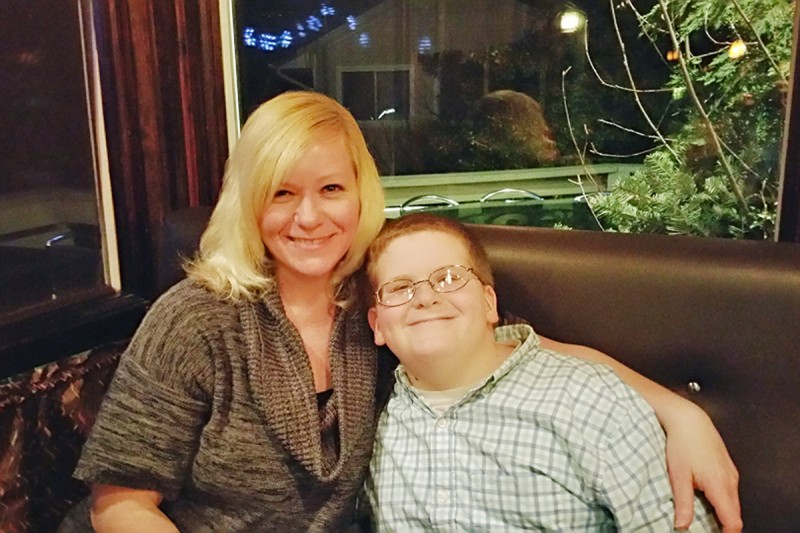
Doctors for Nancy Hughes, pictured here with her son, recommended a watch and wait approach after she was diagnosed with follicular non-Hodgkin’s lymphoma.
When 47-year-old Nancy Hughes was diagnosed with follicular non-Hodgkin’s lymphoma in 2007, she went into fight mode — but her doctor had another idea.
Memorial Sloan Kettering hematologic oncologist John Gerecitano instead recommended the “watch and wait” approach, in which Nancy, from Hampton Bays, New York, would be monitored regularly and put on chemotherapy only if her disease progressed.
“I remember thinking, this is insane. I have cancer, you have to get rid of it,” the mother of two recalls. “And I think that’s everybody’s initial response.”
That’s a response Dr. Gerecitano often finds himself receiving whenever he advocates a watch and wait approach for lymphoma patients.
“This recommendation, especially in lymphoma, doesn’t mean we’re telling patients there’s no treatment for them,” he says. “We know from the data that harm will not come from waiting.”
Also called active surveillance, watch and wait is a common treatment strategy at MSK and other top cancer institutions for lymphomas that pose no immediate threat to a patient’s health.
“Some lymphomas can be treated like chronic conditions such as diabetes or high blood pressure, where we manage them over time,” says Dr. Gerecitano, who recently led a trial for Venetoclax, a new FDA-approved lymphoma drug.
Even though that’s good news, the plan can still lead to tremendous anxiety. Many patients are skeptical about holding off on active treatment.
“It causes understandable anxiety when you tell patients they have cancer and that they should sit on the sidelines,” he says. “We live in a culture in which cancer is seen as an enemy that has to be actively fought.”
But the surveillance is called “active” for a reason. Usually, patients are first assessed every three to six months. Once doctors understand the disease’s growth pattern, they can sometimes space patients’ visits further apart — but they’re always carefully monitored.
Monitoring Can Safely Last for Years
At MSK, lymphoma experts typically recommend active surveillance for around 30% of lymphoma patients. Others are advised to start immediate treatment with chemotherapy, radiation, or surgery. But the hands-off approach has been proven to work just as well in select patients, and also negates the risk of side effects from treatment, Dr. Gerecitano says.
“These are lymphomas that are unlikely to cause an immediate threat to a patient’s overall health,” he says, adding that some lymphomas often take two to five years to cause problems severe enough to tackle with active treatments.
Helping Patients Cope with Anxiety
Despite the evidence, convincing some patients that watch and wait is the best approach is still extremely challenging.
While Nancy initially wanted to eliminate the cancer as quickly as possible, she says she “knew during the first meeting” that she could trust Dr. Gerecitano.

“I just had the utmost faith in his decision-making,” she recalls.
Dr. Gerecitano also tells patients that prudently waiting to launch active treatments allows for “the accrual of better weapons. Almost every year there are breakthroughs in the treatment of lymphomas.”
To respond to patients’ fears, MSK doctors typically schedule longer office visits so they have time to fully explain their recommendations. “When we sit and tell patients all of the information, most feel comfortable with active monitoring,” he says. “We find that investing this time is worth it if we can spare patients the unnecessary side effects of chemo or prevent them from developing treatment resistance.”
To help patients cope with the potential emotional strain of waiting, MSK also offers patient support groups, an online community, and individual and family counseling.
Dr. Gerecitano recommends that his patients stay physically active, not only to decrease the risk of lymphoma-related blood clots but also to keep their energy levels up. “It’s important to get in the best place mentally and physically during that time,” he says. “This will help them when it is time to fight.”
Time Heals
Nine years after her diagnosis — with the disease still posing little threat — Nancy has made peace with her treatment plan.
“I think just as with anything else, time makes it better,” she says. “When you go in for your appointments, those can be a little anxiety producing. But as time as progresses it just gets easier to process.”

